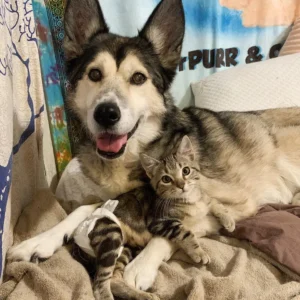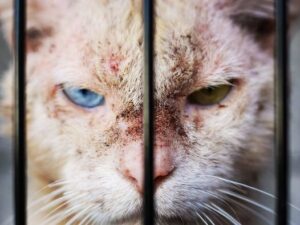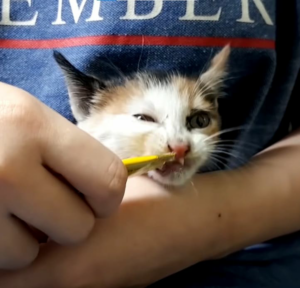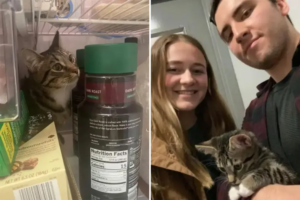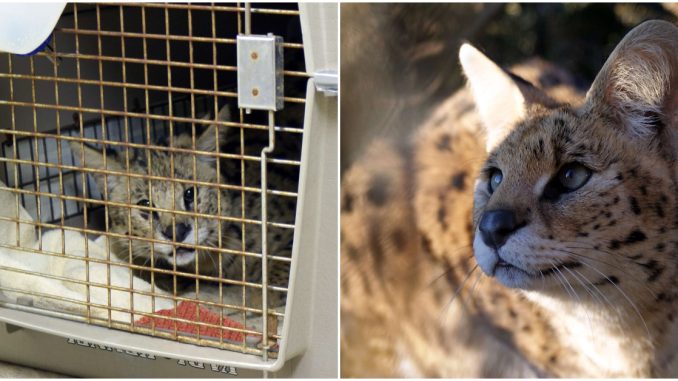
The staff at a unique home for animals in North Carolina first met Elvis about a decade ago, but they’ll never forget it.
The phone rang at Carolina Tiger Rescue in April (CTR). A woman’s voice could be heard on the other end of the line, saying that a friend of hers had a pet she couldn’t care for anymore. The woman did not want to be identified.
A serval cat, a kind of wild feline native to Africa, was the pet.
CTR workers discovered a dog crate on the sanctuary’s doorstep the next day. The serval Elvis was inside, and he wasn’t in great form.

“We discovered Elvis on our doorstep in a dog box, with a note explaining his previous residence and name… ‘Love me gentle, Elvis,’ he said on his message. CTR’s communications coordinator, Jessika Morgan, told The Dodo.
Despite CTR’s explanation to the caller that the serval’s owner would have to meet with a specific person at the sanctuary to organize the rеscuе, especially because there were already two new resident tigers in quarantine and a limited place for the new serval, the owner sounded eager to surrender Elvis.
“He grew to be too big and violent for his owner to handle; it’s not his fault; he’s a wildcat with wildcat tendencies,” Morgan explained. “We figured out a method to do it.”

“We discovered Elvis on our doorstep in a dog box, with a note explaining his previous residence and name… ‘Love me gentle, Elvis,’ he said on his message. CTR’s communications coordinator, Jessika Morgan, told The Dodo.
Despite CTR’s explanation to the caller that the serval’s owner would have to meet with a specific person at the sanctuary to organize the rеscuе, especially because there were already two new resident tigers in quarantine and a limited place for the new serval, the owner sounded eager to surrender Elvis.
“He grew to be too big and violent for his owner to handle; it’s not his fault; he’s a wildcat with wildcat tendencies,” Morgan explained. “We figured out a method to do it.”

It took Elvis some time to acclimate to his new environment, which was large and beautiful. Morgan explained, “He went in circles for a time, signaling to us that he had been confined to that crate for a while.” “We had to sedate him in order to take out his ingrown collar. It hadn’t been changed since he was a kitten, most likеly.”
His rеscuеrs spotted indicators of a bigger problem as they watched him settle in.
“Once Elvis settled in, our animal care team discovered one morning that he wasn’t putting weight on his back leg,” Morgan said.
They gave Elvis’s left hind leg an X-ray and were surprised by what it revealed.
“It was smashed in more than a dozen places,” Morgan added, “and we’re still not sure how it happened.”
After being left in such a situation, the limb could not be salvaged. As a result, Elvis had to transform into a three-legged serval. Fortunately, his strong will got him through this new phase, and he seemed to react well to the loss of his limb.
“Elvis is still running and jumping up onto his platforms on our tour trail!” Morgan said.
And, as friendly as Elvis is with people — he enjoys racing over to greet guests who come through the sanctuary – it’s evident that he has a wildcat nature.

Morgan explained, “Many of our servals were once pets.” “Elvis’ experience exemplifies this, as does our belief that these creatures should not be kept as pets.”
Elvis is now around ten years old and appears to be content at the refuge. However, due to a lack of legislation prohibiting it, many enormous cats, such as servals, are kept as pets across the United States and may be suffering from health and behavioral issues as a result. W
Luckily, Elvis finally has the forever home he needed — with room enough to let his personality shine. “He is indeed a very sweet serval,” Morgan said.
